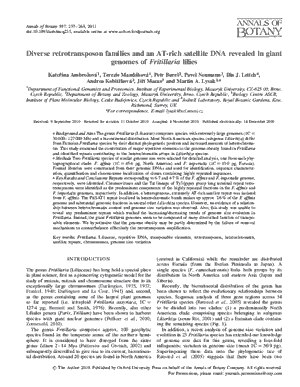NEWS 2011
Diverse retrotransposon families and an AT-rich satellite DNA revealed in giant genomes of Fritillaria lilies
Kateřina Ambrožová ¹, Terezie Mandáková ¹, Petr Bureš², Pavel Neumann³, Ilia J. Leitch⁴, Andrea Koblížková ³, Jiří Macas³ and Martin A. Lysak¹
Annals of Botany 107: 255 – 268 (2011)
doi:10.1093/aob/mcq235
¹Department of Functional Genomics and Proteomics, Institute of Experimental Biology, Masaryk University, CZ-625 00, Brno, Czech Republic
²Department of Botany and Zoology, Masaryk University, Brno, Czech Republic
³Biology Centre ASCR, Institute of Plant Molecular Biology, Ceske Budejovice, Czech Republic
⁴Jodrell Laboratory, Royal Botanic Gardens, Kew, Richmond, Surrey, UK
Abstract
Background and Aims The genus Fritillaria (Liliaceae) comprises species with extremely large genomes (1C ¼ 30 000–127 000 Mb) and a bicontinental distribution. Most North American species (subgenus Liliorhiza) differ from Eurasian Fritillaria species by their distinct phylogenetic position and increased amounts of heterochromatin. This study examined the contribution of major repetitive elements to the genome obesity found in Fritillaria and identified repeats contributing to the heterochromatin arrays in Liliorhiza species.
Methods Two Fritillaria species of similar genome size were selected for detailed analysis, one from each phylogeographical clade: F. affinis (1C ¼ 45.6 pg, North America) and F. imperialis(1C ¼ 43.0 pg, Eurasia). Fosmid libraries were constructed from their genomic DNAs and used for identification, sequence characterization, quantification and chromosome localization of clones containing highly repeated sequences.
Key Results and Conclusions Repeats corresponding to 6.7 and 4.7% of the F. affinis and F. imperialis genome, respectively, were identified. Chromoviruses and the Tat lineage of Ty3/gypsy group long terminal repeat retrotransposons were identified as the predominant components of the highly repeated fractions in the F. affinis and F. imperialis genomes, respectively. In addition, a heterogeneous, extremely AT-rich satellite repeat was isolated from F. affinis. The FriSAT1 repeat localized in heterochromatic bands makes up approx. 26% of the F. affinis genome and substantial genomic fractions in several other Liliorhiza species. However, no evidence of a relationship between heterochromatin content and genome size variation was observed. Also, this study was unable to reveal any predominant repeats which tracked the increasing/decreasing trends of genome size evolution in Fritillaria. Instead, the giant Fritillaria genomes seem to be composed of many diversified families of transposable elements. We hypothesize that the genome obesity may be partly determined by the failure of removal mechanisms to counterbalance effectively the retrotransposon amplification.

